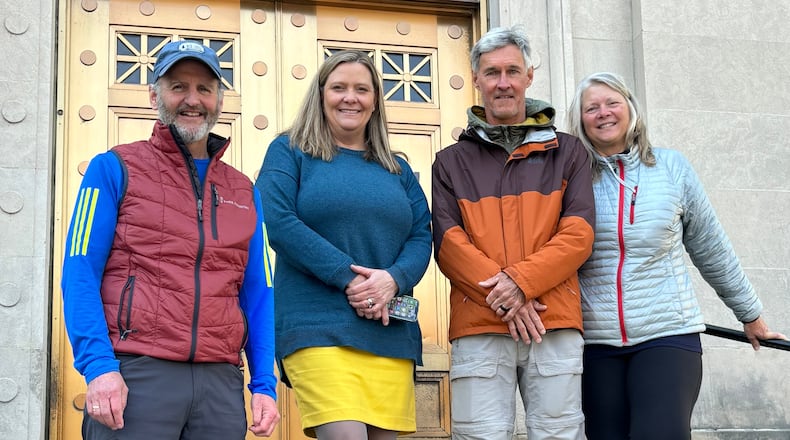It didn’t hurt, McAdams promised her a hotel stay every night along the journey. Many communities have a hotel within walking distance, and those that didn’t were about a mile drive via an Uber.
The McAdams’ daughter, Cammie McAdams of Hamilton, was their support team, driving them to the Courtyard by Marriott in Hamilton for one stay, then picking them up because of a several-mile gap from Rentschler Forest MetroPark to Ohio 73 in Trenton. The trail continues to Sidney, but they ended their walk in Piqua as there was another few-mile gap to the terminus section of the Great Miami River Trail.
This was not a huge challenge for Ron McAdams as it was a paved trail in an urban area. He had spent months hiking the Appalachian Trail in 2012 and the Pacific Crest Trail with his daughter in 2021.
“I laid it out ahead of time, trying to finish up each night within a couple of miles of a hotel,” said McAdams. “There were a couple of places where there were some hotels right on the trail.”
He said they also did not have to walk far to many amenities and attractions ― like coffee shops, restaurants and breweries ― in the communities along the river as they were right off the trail by a few blocks.
“It was convenient from that standpoint,” he said, noting the exceptions of some hotels.
Great Miami Riverway Manager Dan Foley is unaware of anyone walking the length of the trail until now. The McAdams’ eight-day trek ended on March 25, and they had the unique opportunity to visit 11 communities connected by the trail, which is part of the nation’s largest paved trail network.
The Miami Valley Trails system is 350 connected miles and includes the Great Miami River Trail, the Little Miami Scenic Trail, Creekside Trail, Simon Kenton Trail, Xenia Jamestown-Connector, Wright Brothers-Huffman Prairie Trail, Stillwater River Trail, Mad River Trail, Iron Horse Trail, and the Dayton-Kettering Connector.
“The reason the Great Miami Riverway was formed (as a program of the Miami Conservancy District), we realized there was so much connectivity but there’s also a lot more connectivity we can do,” he said, adding the importance of the McAdams’ journey is it can inspire others to do the same thing. “In fact, I need to do it.”
Most of the key gaps are within Butler County, specifically from north of Rentschler Forest MetroPark to Ohio 73 in Trenton. Then from Waterworks Park south to the Butler County line with Hamilton County.
Funding announced in October is expected to close these gaps. OKI Regional Council of Governments awarded MetroParks of Butler County $1.7 million and the city of Fairfield $750,000, and the Butler County Commission awarded MetroParks $2.5 million in ARPA funds.
These yet-to-be-completed sections include a 1.6-mile gap in Lemon Twp., 3.1-mile gap in Lemon, Liberty and Fairfield townships, and a connector from Waterworks Park to Marsh Park in the city of Fairfield.
Fairfield officials added they do not have funding to connect Marsh Park to Furfield Dog Park, but they are doing a feasibility study to connect Waterworks Park to Village Green Park in the city’s Town Center.
The first piece of the nation’s largest connected paved trail system started in 1973 when the first mile was constructed in Troy. Foley said in the next 50 years, he believes there is broad support for even more sections, including connecting the system from Fairfield to the Ohio River in Hamilton County.
Though it will take time and money to fill in gaps and extend the system even further, Foley said what the McAdams’ did “is something that we hope is done by a lot of people, by hundreds of people over the next few years. We think the more people that walk sections of the trail, it’s going to put a reminder in all of our minds of why this trail system is a big part of our economy and it’s a big part of our quality of life.”
About the Author

